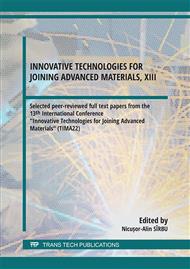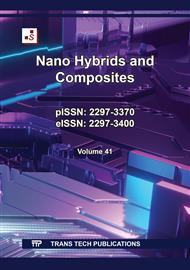[1]
Palmara, G.; Frascella, F.; Roppolo, I.; Chiappone, A.; Chiadò, A.J.B. Functional 3D printing: Approaches and bio applications. Biosens. Bioelectron. 2021, 175, 112849
DOI: 10.1016/j.bios.2020.112849
Google Scholar
[2]
E.B. Duoss, T.H. Weisgraber, K. Hearon, C. Zhu, W. Small, T.R. Metz, J.J. Vericella, H.D. Barth, J.D. Kuntz, R.S. Maxwell, C.M. Spadaccini, T.S. Wilson, Adv. Funct. Mater. 24. 2014, 4905
DOI: 10.1002/adfm.201400451
Google Scholar
[3]
H. Goesmann, C. Feldmann, Angew. Chem., Int. Ed. 2010, 49, 1362
DOI: 10.1002/anie.200903053
Google Scholar
[4]
S. L. Lai, J. Y. Guo, V. Petrova, G. Ramanath, L. H. Allen, Phys. Rev. Lett. 1996, 77, 99
DOI: 10.1103/PhysRevLett.77.99
Google Scholar
[5]
J.S. Kang, J. Ryu, H. S. Kim, H. T. Hahn, J. Electron. Mater. 2011, 40, 2268
DOI: 10.1007/s11664-011-1711-0
Google Scholar
[6]
A.Z. Moshfegh, J. Phys. D: Appl. Phys. 2009, 42, 233001
DOI: 10.1088/0022-3727/42/23/233001
Google Scholar
[7]
Q. Zhang, F. Zhang, X. Xu, C. Zhou, D. Lin, ACS Nano. 2018, 12, 1096
DOI: 10.1021/acsnano.7b06095
Google Scholar
[8]
T. Gissibl, S. Thiele, A. Herkommer, H. Giessen, Nat. Photonics. 2016, 10, 554
DOI: 10.1038/nphoton.2016.121
Google Scholar
[9]
Reiser, A., Lindén, M., Rohner, P., et al. Multi-metal electrohydrodynamic redox 3D printing at the submicron scale. Nat Commun 10, 1853. 2019
DOI: 10.1038/s41467-019-09827-1
Google Scholar
[10]
Q. Zhang, F. Zhang, S. P. Medarametla, H. Li, C. Zhou, D. Lin, Small. 2016, 12, 1702
DOI: 10.1002/smll.201503524
Google Scholar
[11]
Mahnaz Amiri, Khalil Eskandari, Masoud Salavati-Niasari, Magnetically retrievable ferrite nanoparticles in the catalysis application, Advances in Colloid and Interface Science, Volume 271. 2019, 101982, ISSN 0001-8686
DOI: 10.1016/j.cis.2019.07.003
Google Scholar
[12]
L. Lu, P. Guo, Y. Pan, J. Manuf. Sci. Eng. 2017, 139, 071008
DOI: 10.1115/1.4035964
Google Scholar
[13]
E.A. Guzzi, M.W. Tibbitt, Adv. Mater. 2019, 1901994. https://doi.org/10.1002/adma. 201901994
Google Scholar
[14]
A. E. Jakus, E. B. Secor, A. L. Rutz, S. W. Jordan, M. C. Hersam, R. N. Shah, ACS Nano. 2015, 9, 4636
DOI: 10.1021/acsnano.5b01179
Google Scholar
[15]
M. Lee, K. Bae, P. Guillon, J. Chang, Ø. Arlov, M. Zenobi-Wong, ACS Appl. Mater. Interfaces 2018, 10, 37820
DOI: 10.1021/acsami.8b13166
Google Scholar
[16]
A. C. Marques, M. Vale, D. Vicente, M. Schreck, E. Tervoort and M. Niederberger, Global Challenges, 2021, 2000116
DOI: 10.1002/gch2.202000116
Google Scholar
[17]
C. S. Boland, U. Khan, G. Ryan, S. Barwich, R. Charifou, A. Harvey, C. Backes, Z. Li, M. S. Ferreira, M. E. Möbius, R. J. Young, J. N. Coleman, Science 2016, 354, 1257
DOI: 10.1126/science.aag2879
Google Scholar
[18]
T. Hu, X. Mei, Y. Wang, et al., Two-dimensional nanomaterials: fascinating materials in biomedical field, Science Bulletin, 2019
DOI: 10.1016/j.scib.2019.09.021
Google Scholar
[19]
Zachary TA, Ghasemi NMN Additive manufacturing/3D printing of polymer nanocomposites: structure-related multifunctional properties. In: Structure and properties of additive manufactured polymer components. 2020, p.87–113
DOI: 10.1016/B978-0-12-819535-2.00004-1
Google Scholar
[20]
R. Dermanaki Farahani, M. Dubé, Printing polymer nanocomposites and composites in three dimensions, Adv. Eng. Mater. 20 (2) (2018) 1700539
DOI: 10.1002/adem.201700539
Google Scholar
[21]
Jain, K.; Shukla, R.; Yadav, A.; Ujjwal, R.R.; Flora, S.J.S. 3D Printing in Development of Nanomedicines. Nanomaterials 2021, 11, 420
DOI: 10.3390/nano11020420
Google Scholar
[22]
Khan, S.A., Lazoglu, I. Development of additively manufacturable and electrically conductive graphite–polymer composites. Prog Addit Manuf 5, 153–162 (2020). https://doi.org/
DOI: 10.1007/s40964-019-00102-9
Google Scholar
[23]
J. Cesarano, R. Segalman, P. Calvert, Ceram. Ind. 1998, 184, 94
Google Scholar
[24]
S. L. Morissette, J. A. Lewis, P. G. Clem, J. Cesarano, D. B. Dimos, J. Am. Ceram. Soc. 2001, 84, 2462
DOI: 10.1111/j.1151-2916.2001.tb01036.x
Google Scholar
[25]
D.W. Hutmacher, T. Schantz, I. Zein, K.W. Ng, S.H. Teoh, K.C. Tan, J. Biomed. Mater. Res. 2001, 55, 203. https://doi.org/10.1002/1097-4636(200105)55:2<203::AID-JBM1007>3.0.CO; 2-7
DOI: 10.1002/1097-4636(200105)55:2<203::aid-jbm1007>3.0.co;2-7
Google Scholar
[26]
E. Sachs, M. Cima, P. Williams, D. Brancazio, J. Cornie, J. Eng. Ind. Trans. ASME 1992, 114, 481
DOI: 10.1115/1.2900701
Google Scholar
[27]
K. A. M. Seerden, N. Reis, J. R. G. Evans, P. S. Grant, J. W. Halloran, B. Derby, J. Am. Ceram. Soc. 2001, 84, 2514
DOI: 10.1111/j.1151-2916.2001.tb01045.x
Google Scholar
[28]
J. A. Lewis, G. M. Gratson, Mater. Today 2004, 7, 32
DOI: 10.1016/S1369-7021(04)00344-X
Google Scholar
[29]
Ravichandran, D, & Song, K. "One-Step 3D Printed Layers Along With xy-in Plane Directions for Enhanced Multifunctional Nanocomposites." Proceedings of the ASME 2022 17th International Manufacturing Science and Engineering Conference. Volume 1: Additive Manufacturing; Biomanufacturing; Life Cycle Engineering; Manufacturing Equipment and Automation; Nano/Micro/Meso Manufacturing. West Lafayette, Indiana, USA. June 27–July 1, 2022. V001T01A007. ASME
DOI: 10.1115/MSEC2022-85056
Google Scholar
[30]
Dharneedar Ravichandran, Weiheng Xu, Mounika Kakarla, Sayli Jambhulkar, Yuxiang Zhu, Kenan Song, Multiphase direct ink writing (MDIW) for multilayered polymer/nanoparticle composites, Additive Manufacturing, Volume 47, 2021, 102322, ISSN 2214-8604
DOI: 10.1016/j.addma.2021.102322
Google Scholar



